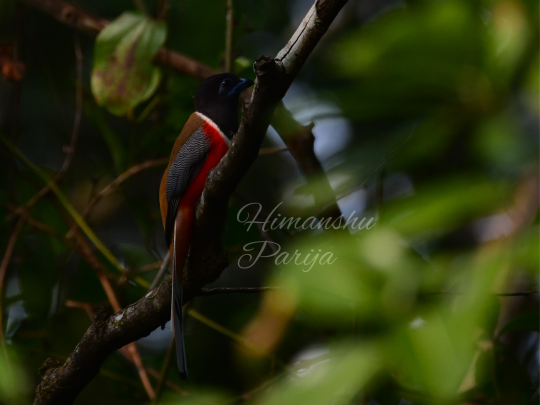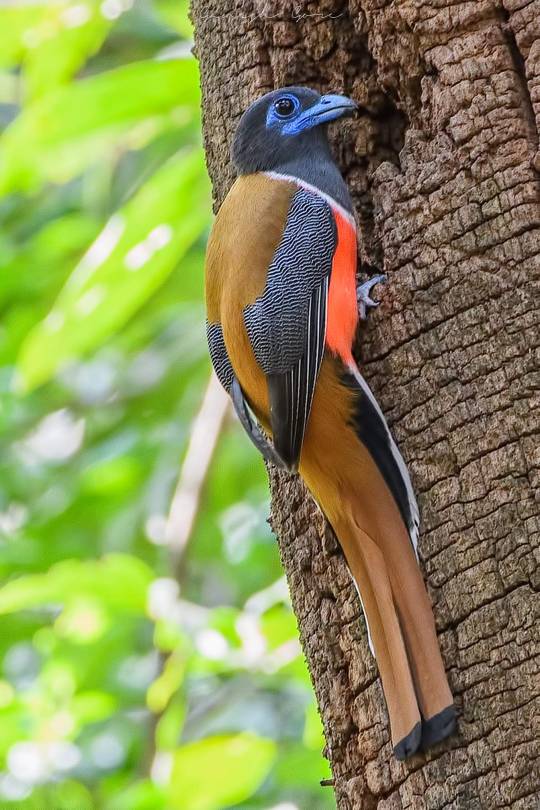#Harpactes fasciatus
Text

Malabar Trogon (Harpactes fasciatus), male, family Trogonidae, order Trogoniformes, India
photographs by Vidya Vijay Kulkarni
336 notes
·
View notes
Text

Malabar Trogon (Harpactes fasciatus)
Sighted at Thattekad, Kerala, India
24 notes
·
View notes
Photo

Harpactes fasciatus by Ganesh Hegde
#bird#birds#animal#animals#biology#nature#wildlife#fauna#Trogoniformes#Trogonidae#Harpactes#Harpactes fasciatus
171 notes
·
View notes
Photo

A new variant has been added!
Malabar Trogon (Harpactes fasciatus)
© Henry C. Richter
It hatches from black, blue, bright, brown, colored, female, male, red, sluggish, unmistakable, and white eggs.
squawkoverflow - the ultimate bird collecting game
🥚 hatch ❤️ collect 🤝 connect
0 notes
Photo

Aloys Zötl (1803 - 1887)
A South Island kokako (Callaeas cinereus) and a female Malabar trogon (Harpactes fasciatus) (?) on a branch of an orange tree, 1870
#Aloys Zötl#austrian#art#bird painting#kokako#exotic birds#malabar#trogon#branch#orange tree#mine#ornithology
23 notes
·
View notes
Photo

Harpactes fasciatus | Biodiversity Heritage Library | Flickr (CC BY 2.0)
1 note
·
View note
Text
NAGARHOLE NATIONAL PARK
It is a part of Nilgiri Biosphere Reserve also known as ‘Rajiv Gandhi National Park’, is one of India’s best known wildlife reserves. This place beckons tourists from all over the world to have a rendezvous with nature and wildlife. It was set up in 1955, enriched with greenish forest cover, little streams, softy valleys and spectacular waterfalls, is one of the best-managed parks in the country.
Naga means snake , hole means pond or stream in local parlance. There is a steam in the west side of the park called Nagarhole. So the name of the park
Fauna of Nagarhole National Park
Sambar deer in nagarhole
Four-horned Antelope (Tetracerus quadricornis) , Indian Palm Squirrel (Funambulus palmarum) also known as Three Striped Palm Squirrel, Indian giant squirrel ( Ratufa indica ) or Malabar Squirrel, Flying squirrel ( Biswamoyopterus biswasi) , Slender loris (Loris tardigradus), Royal Bengal tiger (Panthera tigris or Panthera tigris bengalensis), Sambar (deer) , Porcupine , Wild Boar , Panther , Pangoline , Otter, Striped necked mongoose (Herpestes vitticollis), Small Indian Mongoose (Herpestes javanicus), Common Mongoose (Herpestes edwardsi) , Bonnet Macaque (Macaca radiata) , Sloth Bear (Melursus ursinus), Barking Deer (Muntjac) ,Mouse Deer (Chevrotain), Spotted Deer ( Axis axis) , Common Langur (Hanuman Langur or Presbytis entellus), Wild Dog, Jackal , Civet Cat , Gaur and Elephant.
Birds of Nagarhole National Park
Nal salovar
Peafowl ( Pavo cristatus) , Common Babbler(Turdoides caudata ), Reed Warbler, Bea-eater, Red-whiskered Bulbul ( Pycnonotus jocosus ) , Red-vented Bulbul (Pycnonotus cafer) , Brown dove, Blue-winged Parakeet ( Malabar Parakeet or Psittacula columboides) , Alexandrine Parakeet (Psittacula eupatria) , Ring-Necked Dove (Streptopelia capicola), Spotted Dove (Streptopelia chinensis), Malabar Grey Hornbill ( Ocyceros griseus ) , Malabar Pied Hornbill (Anthracoceros coronatus) , Crested Hawk eagle ( Nisaetus cirrhatus cirrhatus) , Crested Serpent Eagle ( Spilornis cheela or Kanmuri-washi ) , Tawny Eagle (Aquila rapax ) , Blyth’s Myna (Sturnus malabaricus blythii) , Small Minivet ( Pericrocotus cinnamomeus ) , Lorikeets, Blossom-headed Parakeet (Psittacula roseata) , Rose-ringed Parakeet (Psittacula krameri), Southern Treepie (Dendrocitta leucogastra) , Green Imperial Pigeon (Ducula aenea) , Malabar Trogon ( Harpactes fasciatus ) and Bar-winged Flycatcher shrike ( Hemipus picatus ).
Reptiles of Nagarhole National Park
King Cobra, Spectacled cobra ( Common cobra or Naja naja), Banded Krait (B. fasciatus), Bamboo viper ( Trimeresurus stejnegeri ) , Pit viper, Russell’s viper, Indian Rock Python (Python molurus ), Monitor Lizard, Tortoise and Toads.
Elephant in nagarhole
Location
Nagarhole National Park spreads over two districts of Karnataka state – Mysore and Kodagu. Its a relatively large national park covering an area more than 600 sq. kilometers ( 230 sq miles)
Nagarhole Opening Hours
The main road through the park is open from 6 a.m. until 6 p.m., all year round. Safaris take place in the early morning from 6 a.m to 9 a.m., and again in the afternoon from 3 p.m. to 5 p.m.
Nagarhole Cost
The park entrance fee is 200 rupees ($4.50) for foreigners. The forest department runs one hour safaris for 65 rupees ($1.50). Alternatively private vehicles can go on safari for 550 rupees ($12) per car or jeep, plus 200 rupees for the cost of a guide (required). Trekking costs 75 rupees ($1.80) for one day, plus 250 rupees ($6) for a guide. A 30 minute elephant ride costs 75 rupees. Jeeps can be hired for around 800 rupees ($18) per day from the forest department office in Hunsur, 45 kilometers before the park. Hotel operators also run safari tours and other activities.
MaleGaur in Nagarahole
Nagarhole Travel Tips
Nagarhole can be explored by jeep, elephant back, and boat. Visitors can also go trekking. The park offers the opportunity to see elephants close up in their natural habitat, and it’s not unusual to see herds of elephants on the river bank. However, the likelihood of seeing a tiger here is rare compared to parks such as Bandhavgarh in the north. A good thing about Nagarhole is that the main forest reserve office (where the safaris start from) is located right inside the park. This means that visitors can pass through quite a bit of the park area on their own.
How to get there
Tiger
By Road
Nagarhole National park is well connected to adjoining areas of Karnataka. Motorable highways link the park to the towns of Madikere (90 km) and Mysore (96 km) . The journey from both places lasts approximately 2 hours.
By Rail
The nearest well-connected railway junction is Mysore.
By Air
The nearest international airport is Bangalore (220 km). Various airlines link Bangalore to the rest of the nation.
Gallery
Deers at night
Sambar deer in nagarhole
Elephant in nagarhole
MaleGaur in Nagarahole
Nagarhole park entry
Tiger
Nagarhole National Park NAGARHOLE NATIONAL PARK It is a part of Nilgiri Biosphere Reserve also known as 'Rajiv Gandhi National Park', is one of India’s best known wildlife reserves.
#deers in nagarhole#Elephant in nagarhole#KARNATAKA#NAGARHOLE#RAJIV GANDHI NATIONAL PARK#Sambar deer in nagarhole
0 notes
Text
Popular on 500px : Malabar trogon (Harpactes fasciatus) by nisthi https://t.co/0FSWE87F2N
Popular on 500px : Malabar trogon (Harpactes fasciatus) by nisthi http://pic.twitter.com/0FSWE87F2N
— hani ghabbar (@almabani_2011) October 11, 2017
via Twitter https://twitter.com/almabani_2011
October 11, 2017 at 12:19PM
0 notes
Text

Yogesh Deshpande
Malabar trogon female
Harpactes fasciatus
OLD Magazine House, Ganeshgudi, Karnataka
76 notes
·
View notes
Photo

Harpactes fasciatus 1838 - high resolution image from old book.
0 notes
Text

Yogesh Deshpande
The Malabar trogon (Harpactes fasciatus)
OLD Magazine House, Ganeshgudi,
Karnataka
88 notes
·
View notes
Text

Yogesh Deshpande
The Malabar trogon (Harpactes fasciatus)
OLD Magazine House, Ganeshgudi, Karnataka
35 notes
·
View notes
Photo

A new variant has been added!
Malabar Trogon (Harpactes fasciatus)
© Jean Gabriel Prêtre
It hatches from black, blue, bright, brown, colored, female, male, red, sluggish, unmistakable, and white eggs.
squawkoverflow - the ultimate bird collecting game
🥚 hatch ❤️ collect 🤝 connect
0 notes
Photo

Malabar trogon The Malabar trogon (Harpactes fasciatus) is a species of bird in the trogon family. It is found in the forests of Sri Lanka and peninsular India. In India it is mainly found in the Western Ghats, hill forests of central India and in parts of the Eastern Ghats. They are insectivorous and although not migratory, may move seasonally in response to rain in hill forest regions. Like in other trogons, males and females vary in plumage. The birds utter low guttural calls that can be heard only at close quarters and the birds perch still on a branch under the forest canopy, often facing away from the viewer making them easy to miss despite their colourful plumage. These birds usually perch still, especially when alarmed and will sometimes clinging laterally to branches. When calling they sometimes raise and lower their tail. The call is a series of guttural or purring notes. The song of the male is a series of percussive kyau calls. The breeding season in India is mainly February to May (before the Monsoons) while it is March to June in Sri Lanka. NIKON D500 F6.3 1/400 s 600.00mm ISO 4000 White balance Auto No flash (at Ganeshgudi) https://www.instagram.com/p/B69cG1UHGTc/?igshid=15rdtpwuwwak6
0 notes
Photo

Malabar trogon (Female) The Malabar trogon (Harpactes fasciatus) is a species of bird in the trogon family. It is found in the forests of Sri Lanka and peninsular India. In India it is mainly found in the Western Ghats, hill forests of central India and in parts of the Eastern Ghats. They are insectivorous and although not migratory, may move seasonally in response to rain in hill forest regions. Like in other trogons, males and females vary in plumage. The birds utter low guttural calls that can be heard only at close quarters and the birds perch still on a branch under the forest canopy, often facing away from the viewer making them easy to miss despite their colourful plumage. Like most other trogons, these birds are brightly coloured and sexually dimorphic. The male has a slaty black head and breast with a white border to the black bib separating it from the crimson on the underside. The back is olive-brown to chestnut. The wing coverts are black with fine white vermiculations. They have 12 tail feathers that are graduated.The central tail-feathers are chestnut with a black tip, with the second and third pairs from the middle having more black than chestnut. The outer three pairs have long white tips. The female lacks the contrasting black and crimson and has only a slightly darker head and breast that shades into the olive brown on the back while the crimson of the underside of the male is replaced by ochre. In both sexes, the beak is bluish as is the skin around the eye. The iris is dark brown and the feet are pale bluish.The nostrils are covered by tufts of filoplumes. Camera NIKON D500 Aperture F6.3 Focal length 600.00 mm Flash No flash White balance Auto ISO 5600 Exposure time 1/500 s (at Old Magazine House - Jungle Lodges and Resort) https://www.instagram.com/p/B5-VL-OnZRf/?igshid=10n5egft1p1zy
0 notes
